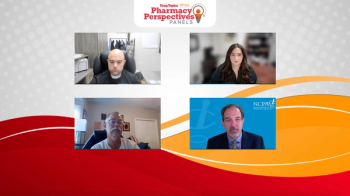
- Total Pharmacy® June 2023
- Volume 01
- Issue 03
Patients Often Lose in the Battle Between Pharmaceutical Companies and PBMs
Over the last 5 years, both PBMs and drug manufacturers have implemented restrictions that raise patients’ cost burden for specialty medications.
Brooke Loving doesn’t take the medication that would keep her von Willebrand disease under control. Because of the cost, she has made the decision to focus on treating her children instead: Loving and 3 of her 8 children have been diagnosed with von Willebrand disease, a bleeding disorder that is characterized by low levels of von Willebrand factor, a protein that helps blood clot.
Two of Loving’s children take Humate-P, a von Willebrand factor/factor VIII replacement therapy. It’s expensive, but CSL Behring, the manufacturer of Humate-P, offers co-pay assistance of $10,000 a year. In previous years, Loving explained, they would use the co-pay card when it counted toward their out-of-pocket deductible. “When that ran out, our portion was about $300 a week,” she said.
But Blue Cross Blue Shield of Alabama, Loving’s insurance company, and the pharmacy benefit manager (PBM) Express Scripts changed their policy and have implemented a program in which the co-pay assistance doesn’t count toward the family’s deductible. (The family’s specialty pharmacy is Accredo.)
Loving and her family decided not to use the co-pay assistance because it did not count toward their deductible. The family has a high-deductible plan through the employer of Loving’s husband: $9100 for an individual and $18,200 for the family, the out-of-pocket maximums set by the Affordable Care Act (ACA).1
“We needed to meet the deductible to assist with all the other appointments and meds we utilize as a family,” Loving said. “Originally, we thought it would make more sense, but this may have been an uneducated decision. I didn’t [and] still don’t feel I understand any of this mess. It should be simple.”
After these changes, the most recent co-pay for Loving’s daughter Katy’s medication was $5000 for 4 weeks of medicine. “I can count numerous times where we’ve had to pick between getting groceries for the week or doing a treatment,” Loving said. “Unfortunately, in the last 6 months, I was hit with the fact that I had made a bad mom choice.”
Her choice: She didn’t immediately take her 9-year-old son, Kason, who also has von Willebrand disease, to the doctor when he complained about shoulder pain after he had fallen on the playground. “We were not educated to know and listen to some of the cues, and we did not treat my son, because treating him would be costly.”
Patients Face Access Challenges
Over the past several years, PBMs have implemented restrictions that put more of the costs of specialty medications on patients such as Loving and her family. One such restriction that has impacted Loving’s family is a co-pay accumulator, in which any co-pay assistance would not count, or accumulate, toward the family’s deductible. Accumulator programs shift costs to patients, and critics say they amount to double-dipping because the plan is getting both the value of the co-pay and the patient deductible.
“In November 2016, we noticed some benefit changes to one plan around co-pay assistance and it not accumulating toward a patient’s out-of-pocket deductible,” Kollet Koulianos, vice president of payer relations at the National Hemophilia Foundation, said in an interview. “We knew then that there would be severe unintended consequences for both the patient and self-funded plans.”
Since then, co-pay accumulator programs have become common. According to a 2023 report from The AIDS Institute, at least two-thirds (64%) of health plans in the country include a co-pay accumulator policy. PBM accumulator programs combined with high-deductible health plans have put many patients with chronic diseases in a difficult position.2
The 3 largest PBMs—CVS, Express Scripts, and Optum Rx, which control about 80% of the market—all use accumulator programs. A spokesperson for Optum Rx said that this program is not new; it was introduced nearly 5 years ago.3 CVS and Express Scripts did not respond to requests about their programs. But in 2018, CVS executives said4 that co-pay cards encourage the use of more expensive therapies by negating the impact of higher cost-sharing tiers on member out-of-pocket cost; that same year, Express Scripts said that a co-pay accumulator helps to level the playing field.5
Also growing are the use of “maximizer” programs, which classify a subset of specialty medications as nonessential. This removes the ACA’s requirements related to maximum out-of-pocket limits. These programs maximize patients’ use of manufacturers’ co-pay assistance programs by limiting PBMs’ exposure to specialty drug costs. The proportion of commercial patients exposed to maximizers hastripled since 2019 in the autoimmune brands from 4% to 14%, as well as for multiple sclerosis products from 5% to 15%, according to IQVIA. Among oncology patients, maximizer prevalence more than doubled from 5% to 13%.6
Pharmaceutical Companies Fight Back
But now pharmaceutical companies are fighting back against these PBM efforts to limit patient assistance. Some pharmaceutical companies have begun to lower the total amount of assistance given to patients through co-pay cards when accumulator or maximizer programs are in effect.
“It’s a basically a mud fight between drug manufacturers and the insurers and pharmacy benefit managers,” Geoffrey Joyce, PhD, director of health policy at the University of Southern California (USC) Schaeffer Center and chair of the department of Pharmaceutical and Health Economics at the USC School of Pharmacy, said in an interview. “In the case of accumulators, it doesn’t benefit the patients. All of this is between the manufacturers and the insurers. And each wants a bigger piece.”
One example of a company lowering the value of its assistance is CSL Behring, which produces Humate-P, the therapy that Loving’s family takes. While the terms7 for the co-pay don’t specifically use the term “accumulator,” they do say that patients whose insurance policy impose limitations on co-pay assistance are not eligible.
CSL Behring isn’t the only pharmaceutical company to change the terms of their co-pay cards when insurers have accumulator programs. AbbVie, for example, has lowered the annual maximum that patients can receive from co-pay cards. For its blockbuster arthritis drug adalimumab (Humira), the company has lowered its assistance from $14,000 a year to $4000 a year if a patient’s plan has an accumulator program.8 AbbVie has also lowered assistance for upadacitinib (Rinvoq),9 another arthritis therapy, and for the psoriasis therapy risankizumab-rzaa (Skyrizi).10 For upadacitinib, the annual maximum was lowered from $14,000 to $6000 if there is a co-pay or maximizer program; the annual limit is also $6000 for risankizumab-rzaa.10
Janssen is another manufacturer that is limiting co-pay cards for patients with accumulator plans for its psoriasis/ulcerative colitis therapyustekinumab (Stelara).11 Patients now have a limit of $6000 annually for its $5-a-dose Stelara WithMe Savings program. For the co-pay cards for the anticancer therapy trabectedin (Yondelis) and the pulmonary hypertension treatment bosentan (Tracleer), Janssen doesn’t specifically mention accumulator programs but does say, “The cost support is meant solely for patients—not health plans and/or their partners.”12
Other companies—such as Teva for deutetrabenazine (Austedo)13 for tardive dyskinesia and Sanofi/Regeneron for sarilumab (Kevzara)14 for rheumatoid arthritis—don’t specify whether annual limits will be reduced but do say that they reserve the right to change the terms of the co-pay card.
The pharmaceutical companies would not respond to questions about their lowered assistance, but Matthew Gibbs, PharmD, president of Capital Rx, said he sees these efforts to lower co-pay assistance as a veiled threat to PBMs that have accumulator programs. “They’ll never admit this, but it’s probably tied to their global rebate contracting: ‘If you want a rebate on this drug, you can’t be doing this activity.’ Also, this [limiting of assistance] is not on all products. It’s for specific products, which implies they want to continue to drive market share on their drugs.”
All of this leaves patients stuck in the middle between 2 large health care players. Patients often don’t know if their insurance includes an accumulator program; if they do, they might not know what that means.
Approximately 70% of people with multiple sclerosis, for example, have relied on patient assistance programs at some point, indicating that patients are struggling with managing the costs of their disease, Bari Talente, executive vice president, advocacy and health care access, for the National MS Society, told Formulary Watch®.
“Co-pay accumulators hurt patients,” she continued. “People with high health care costs are stuck in the middle of fights between PBMs [and] insurers [vs] pharmaceutical manufacturers. While they continue to try to outmaneuver each other, patients are the ones facing the very real consequences.”
But Gibbs doesn’t believe accumulators hurt patients. “At the end of the day, patients are still paying way less than they would have,” he said.
Dea Belazi, president and CEO of AscellaHealth, said the conflict between pharmaceutical companies and PBMs over co-pay cards create a checks-and-balances system.
“This battle of pharma versus payers has been going on forever,” he said. “But this also creates a balance where both sides of the table will be [checking] on each other. Until we figure out a better model, you want both pharma and PBMs on the opposite of the table duking it out. I’m nervous if one or the other get the upper hand where it’s not going to be OK.”
States, Advocacy Groups Speak Out Against Accumulator Programs
Co-pay programs are a symptom of a problem created by ever-higher list prices, said Sarah K. Emond, MPP, executive vice president and chief operating officer at the Institute for Clinical and Economic Review. “The [original] goal of cost-sharing and accumulators was to incentivize patients to choose cost-effective, effective, lower-cost options,” Emond said. “But the problem comes in when they are applied to drugs with no other options. They are not incentivizing any value-based purchasing behavior because patients don’t have a choice.”
From 2019 to 2022, the prevalence of accumulator programs doubled to 14% for autoimmune therapies and 20% for oncology products.15 The growth is expected to reach 25% as vertically aligned specialty pharmacies and PBMs continue to expand their programs and smaller specialty pharmacies develop programs to compete for the patients in these markets.
Some states have implemented legislation to regulate co-pay accumulators. Laws in 16 states16 and Puerto Rico require any payment or discount be applied to a consumer’s annual out-of-pocket cost-sharing requirement. At the federal level, a bipartisan bill, H.R. 830, the Help Ensure Lower Patient Copays Act,17 was introduced earlier this year in the House of Representatives that would require health plans to count co-pay assistance toward cost sharing.
Patient, provider, and consumer organizations representing a wide range of illnesses support the bill, and in February, 29 organizations signed a brief in support of a Pharmaceutical Research and Manufacturers of America lawsuit against the Department of Health and Human Services for prohibiting co-pay coupons in Medicare.18
Accumulators and High-Deductible Plans Put Patients at Risk for High Costs
PBM accumulator programs, combined with high-deductible health plans, have put many patients with chronic diseases in a difficult position, said Koulianos. “These are patients with commercial insurance and are contributing members of society, but they live paycheck to paycheck just like many in America,” she said.
More than half (55.7%) of American private-sector workers were enrolled in high-deductible plans in 2021, the highest on record and the eighth-straight yearly increase, according to a survey by ValuePenguin, a LendingTree company that provides analysis for consumer financial decision-making.19 This is up 83.7% from 2013.
But Koulianos said 59% of patients with hemophilia are part of high-deductible health plans, based on a survey by the National Hemophilia Foundation and partners.20 And nearly 7 in 10 (69%) people with an income less than $40,000 a year who have private coverage say they or a loved one have a high-deductible health plan.
“This is a problem because when you have a deductible, regardless of the amount, you must pay the full deductible before insurance kicks in,” she said. “If you have medicines that cost way more than these deductibles, you’re going to be hit every January having to pay for the full cost, and patients wouldn’t have yet saved anything in their HSA.”
Health savings accounts, designed to help patients set aside money to pay for medical expenses, have limits on contributions. For 2022, contributions were set at $3650 for individual coverage and $7300 for family coverage.21
Sixty-five percent of the National Hemophilia Foundation respondents said they have used or are using co-pay assistance programs for their medications or treatments. Six in 10 patients and caregivers say they would have extreme difficulty affording their treatments and medications without co-pay assistance programs being applied to their out-of-pocket costs.
High-deductible plans coupled with health savings accounts were added to
the ACA in 2014 as a way to provide insurance coverage with lower premiums. But those within the pharmacy benefits industry say the health care system, especially after the passage of the ACA, has set up the wrong kind of incentives, allowing pharmaceutical companies to set extremely high prices for specialty drugs.
“It’s the law’s unintended consequences,” said Pramod John, PhD, CEO of Vivio Health. “The ACA’s intent was not that providers now can charge whatever they wanted for service, whether a drug manufacturer or hospital. It was trying to protect a member who could have $1 million in out-of-pocket costs in a year. This is when we started to see expansion of drug pricing because now with out-of-pocket limits, it doesn’t matter whether a drug costs $6,000 or $600,000.”
Pharmaceutical manufacturers, John said, started offering co-pay cards after high-deductible plans were launched. “Now a drug manufacturer can arbitrarily raise the price of a drug or remove all pricing sensitivity for the cost of the drug by paying patients’ co-pays and deductibles.”
Ultimately, it’s a steering mechanism, he said. “Co-pay cards set up economic incentives that favor the wrong behavior,” John said. “We’ve removed pricing sensitivity for patients and incentivized providers to be able to jack up the price of goods and services.”
This article originally appeared on formularywatch.com and has been lightly edited.
References
Out-of-pocket maximum/limit. Healthcare.gov. Accessed May 16, 2023. https://www.healthcare.gov/glossary/out-of-pocket-maximum-limit/
TAI Report: Copay accumulator adjustment program. The AIDS Institute. February 7, 2023. Accessed May 16, 2023. https://www.theaidsinstitute.org/copayco-pays/tai-report-copayco-pay-accumulator-adjustment-programs
UnitedHealthcare copay card solutions: Accumulator benefit. UnitedHealthcare. Accessed May 16, 2023. https://www.uhc.com/content/dam/uhcdotcom/en/Pharmacy/PDFs/Copay-Card-Solutions-Accumulator-Benefit-Flyer.pdf
Singh S. A foundational approach to specialty cost management. CVS Health. Published June 19, 2018. Accessed May 16, 2023. https://payorsolutions.cvshealth.com/insights/a-foundational-approach-to-specialty-cost-management
Copay accumulator programs level the out-of-pocket playing field. Express Scripts. March 22, 2018. Accessed May 16, 2023. https://www.express-scripts.com/corporate/articles/copay-accumulator-programs-level-out-pocket-playing-field
Myshko D. IQVIA: accumulator and maximizer programs are growing. Formulary Watch. January 27, 2023. Accessed May 16, 2023. https://www.formularywatch.com/view/iqvia-accumulator-and-maximizer-programs-are-growing
Copay terms and conditions. CSL Behring. Accessed May 16, 2023. https://www.cslbehring.com/patients/support-and-assistance/copay-terms-and-conditions
Humira complete. Humira. Accessed May 16, 2023. https://www.humira.com/humira-complete/cost-and-copay#savingscardterms
Cost & savings. Rinvoq. Accessed May 16, 2023. https://www.rinvoq.com/cost#termsandConditions
Skyrizi complete. Skyrizi. Accessed May 16, 2023. https://www.skyrizihcp.com/dermatology/support
Stelara WithMe. Stelara. Accessed May 16, 2023.
https://www.stelarawithme.com/sites/www.stelarawithme.com/files/stelara-savings-program-overview.pdf Helping patients afford Tracleer. Janssen CarePath. Accessed May 16, 2023.
https://www.janssencarepath.com/hcp/tracleer/affordability Terms & conditions. Austedo. Accessed May 16, 2023.
https://www.austedo.com/globalassets/austedo/copay-card-terms-and-conditions.pdf The KevzaraConnect copay card. Kevzara. Accessed May 16, 2023.
https://www.kevzara.com/starting-kevzara/kevzaraconnect-copay-card/#copay-t-and-c Five years and counting: deductible accumulators and copay maximizers in 2022. IQVIA. December 25, 2022. Accessed May 16, 2023.
https://www.iqvia.com/locations/united-states/library/white-papers/five-years-and-counting-deductible-accumulators-and-copay-maximizers-in-2022 Gooding M, Sikora K, Finkel M. State copay accumulator bans will affect 13% of US commercial lives. Avalere. January 5, 2023. Accessed May 16, 2023.
https://avalere.com/insights/state-copay-accumulator-bans-impact-11-of-us-commercial-lives The Help Ensure Lower Patient Copays Act, HR 830, 118th Cong (2023). Accessed May 16, 2023.
https://buddycarter.house.gov/uploadedfiles/help_copays_xml.pdf Levinson DR. Manufacturer safeguards may not prevent copayment coupon use for Part D drugs. Department of Health and Human Services. September 2014. Accessed May 16, 2023.
https://oig.hhs.gov/oei/reports/oei-05-12-00540.pdf DeMarco J. Rate of workers enrolled in high-deductible health plans jumps for 8th year in row to record 55.7%. Updated January 30, 2023. Accessed May 16, 2023.
https://www.valuepenguin.com/high-deductible-health-plan-study National patient & caregiver survey: COVID-19 has exacerbated treatment affordability challenges & health inequities for vulnerable Americans who rely on copay assistance to access their medications. News release. National Hemophilia Foundation. May 19, 2021. Accessed May 16, 2023.
https://www.hemophilia.org/sites/default/files/document/files/NHF%20Press%20Release%20-%20National%20Patient%20and%20Caregiver%20Survey%20on%20Copay%20Assistance.pdf Health savings account (HSA). Healthcare.gov. Accessed May 16, 2023.
https://www.healthcare.gov/glossary/health-savings-account-hsa/
Articles in this issue
over 2 years ago
DSCSA is Coming. Are you Ready?over 2 years ago
Technology Tools Can Improve Customer Serviceover 2 years ago
Creating and Leveraging Community Partnerships That Lastover 2 years ago
Pharmacists Find Marketing Success With Instagram, TikTokNewsletter
Pharmacy practice is always changing. Stay ahead of the curve with the Drug Topics newsletter and get the latest drug information, industry trends, and patient care tips.





























































































































